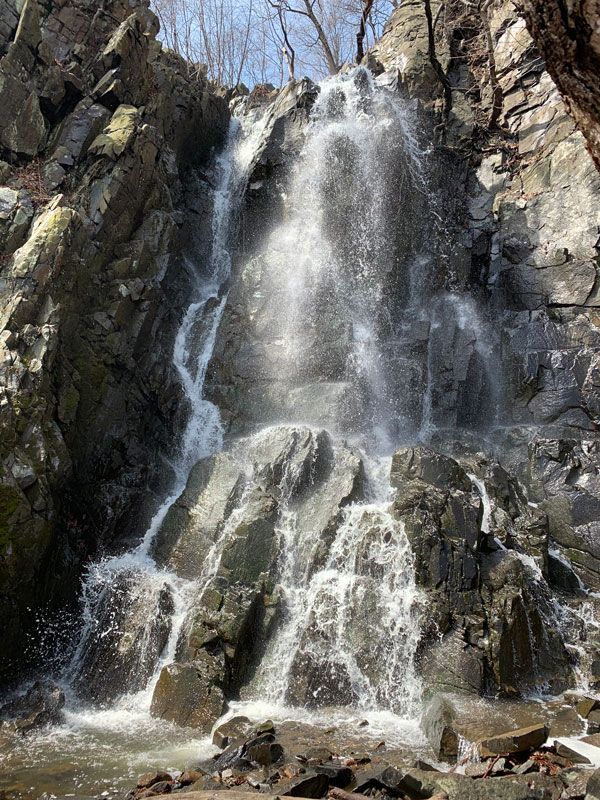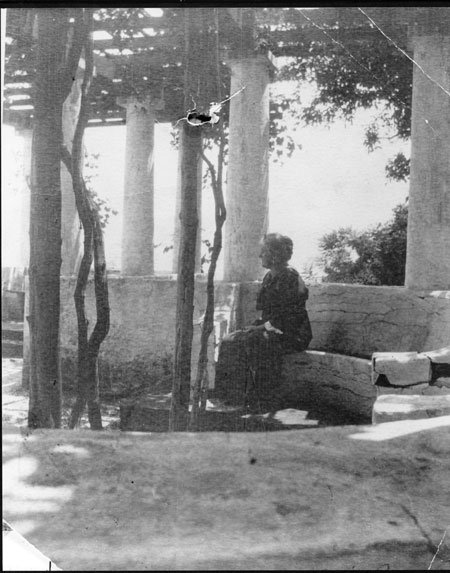The Cascade
A “Cliff Notes” Story
September 2013
You hear the Cascade before you see it. The trail has taken you downhill beside a rocky stream bank, the Hudson River a far off glimmer through the tree trunks ahead. The trail takes a sharp left turn, north, away from the stream — you now skirt the edge of a hillside steep enough to be called a cliff. And that’s just when you first hear it: the steady music of falling water. The trail doubles back on itself again, and again, down and down tall steps built from railroad ties. There is one final run of steps so crazy tall you think about taking them on your butt, but a right turn at the end of them has you walking south, now close to river level, back toward the source of the music. And finally you see it: the stream you had been following down the mountain is now overhead, plunging into thin air and spattering against rock ledges a hundred feet above your head. The air is filled with the scent of water flashing white.

When you take your eyes off the falls to look around, you realize you’re standing on ruins.
In August of 1874, J. H. Serviss of Englewood compiled a map of Palisades, New York, just over the border from New Jersey. The map included Snedens Landing, what was from Colonial days the western terminus of the Dobbs Ferry crossing, and what in Serviss’s day became the site of summer homes for wealthy New York families. On his map Serviss gave this particular waterfall, just south of Snedens, the name “Peanut Leap Cascade.”
From a man-made pool that has mostly returned to nature at the base of the falls, a run of crumbling concrete stairs takes you down to river level. The pool spills across the rocky ground at your feet and gurgles on to the river. Built into the hillside are stone and brick walls with archways in them. On the riverbank itself is another low wall; columns are scattered about it on the ground.
The ruins are from a garden designed by the artist Mary Lawrence-Tonetti. Mary’s father, Henry Effingham Lawrence, a descendant of New York gentry going back to the 1600s, built the family’s summer retreat, “Cliffside,” at Snedens around the time of the Civil War. Mary was born in 1868. She and her siblings spent their summers at Cliffside, getting to know the area in the course of their childhood adventures, including the waterfall — what they called simply “the Cascade” — which was part of the family property, but left undeveloped.
From early on Mary showed an uncommon artistic bent, one that her family permitted her to cultivate. She took lessons and developed her abilities in sculpture, gaining the notice of none other than Augustus Saint-Gaudens, the most prominent American sculptor of the day. She became his favorite pupil.
A privileged teenager of her day, she also had the opportunity to tour Europe with a beloved aunt — where her artist’s eye was enchanted by a cliff-edge monastery on Italy’s Amalfi Coast.
For the World’s Columbian Exposition in Chicago in 1893, Saint-Gaudens gave Mary, just twenty-five years old, the honor of designing the central statue of Columbus.
Mary met and fell in love with a French sculptor, François Tonetti. They married in 1900. They lived in New York, where they also kept their sculpting studio, but still summered at Cliffside. It was around this same time that Mary designed her “Italian Gardens” at the Cascade. It was in part to protect the property from a proposed railroad (never built), as well as from the new Palisades Commission, which, the family feared, might take the property from them if it was not in use. She was assisted by prominent architect Charles McKim; their design echoed Mary’s teenage memories of the monastery on the Amalfi Coast. Along the riverbank they sited a pergola, its white pillars supporting a grape arbor.

For the next decade and more, Mary and François entertained lavishly at their gardens at the Cascade. Their friends, many of them prominent artists, architects, and the like, came by train from the city to Dobbs Ferry; across on the little motor launch that still plied the route of the Colonial-era ferry; and then down a woodland path to the beautiful waterfall with its Old World-style pools and arches. Fountains bubbled out of lion heads in walls beneath the pools. They held illuminations and feasts, serving exotic new foods (new to Americans, anyway), crazy things like spaghetti.
While Mary turned most of her attention to their young family, she continued to assist François in his work, which included a number of prominent commissions. He returned to France to serve during the First World War; he came back to the United States after the war, but his health was ruined, and he died in 1920. Mary continued to raise their five children, eventually moving to Snedens year-round.
In her later years, she took pleasure in cheaply renting cottages the family owned at Snedens to promising young artists who caught her eye. She died in 1945.
Despite a fence around it, people still found their way onto the property by the Cascade. Vandals took their toll.
In 1979, Anne T. Gugler and other members of the Tonetti family donated the Cascade property to the Palisades Interstate Park Commission. The next year a trail was built from the top of the cliffs to the bottom area by Summer Youth Work Program employees. Through private funding, the Commission was able to hire two seasonal employees to patrol and maintain the area for summer use. In 1981, steps for the trail were built. Approximately 7,000 persons visited the site in 1982.
Time continued to take its toll on the property, however; Hurricane Sandy toppled the last of the pergola’s pillars. But “the Cascade” remains a hauntingly beautiful site, worth even the hike back up all those railroad tie stairs.
– Eric Nelsen & Jennette Zitelli –

